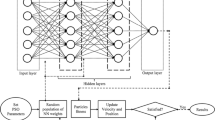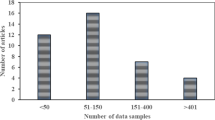Abstract
One of the critical issues faced by the desalination plants is an accurate analysis of their real-time performance. Soft computing techniques are efficient in overcoming these issues and predicting accurate outcomes. In this paper, models based on the third version of the modified particle swarm optimization algorithm called autonomous groups particles swarm optimization—based artificial neural network (AGPSO3-ANN) have been proposed for accurate prediction of permeate flux of reverse osmosis (RO) desalination plant. It employs remarkable optimization strategy that demonstrates superiority than the conventional PSO-ANN techniques, to update acceleration factors (c1 and c2) and to screen the global best solution. Here, four input parameters: evaporator inlet temperature, feedwater salt concentration, condenser inlet temperature, and feed flow rate have been considered for the modeling, and models' performance evaluated in terms of the regression coefficient (R2) and mean square errors (MSE). The results show an impressive agreement between simulated and experimental datasets indicating that the proposed approach is strongly capable of finding optimal solutions to predict accurate results with minimum errors (R2 = 99.2%, MSE = 0.005) compared to the existing ANN approaches. This demonstrates that the proposed models based on such soft computing tools like AGPSO3-ANN are perfect for analyzing and predicting real-time desalination plant performance that would present an effective way for improved process control and efficiency for plant engineers.







Similar content being viewed by others
Availability of Data and Material
References are given to the data as and when it is used.
Code availability
Custom code.
References
Ibrahim, Y.; Ismail, R.A.; Ogungbenro, A.; Pankratz, T.; Banat, F.; Arafat, H.A.: The sociopolitical factors impacting the adoption and proliferation of desalination: a critical review. Desalination 498, 114798 (2021)
Eke, J.; Yusuf, A.; Giwa, A.; Sodiq, A.: The global status of desalination: an assessment of current desalination technologies, plants and capacity. Desalination 495, 114633 (2020)
WHO, UNICEF, Joint Monitoring Programme Progress on Drinking Water, Sanitation and Hygiene., (2017)
Shannon, M.A.; Bohn, P.W.; Elimelech, M.; Georgiadis, J.G.; Marĩas, B.J.; Mayes, A.M.: Science and technology for water purification in the coming decades. Nature 452, 301–310 (2008)
Altmann, T.; Das, R.: Process improvement of sea water reverse osmosis (SWRO) and subsequent decarbonization. Desalination 499, 1–13 (2021)
Elimelech, M.; Phillip, W.A.: The future of seawater desalination: Energy, technology, and the environment. Science 333, 712–717 (2011)
Mahadeva, R.; Manik, G.; Verma, O.P.; Sinha, S.: Modelling and simulation of desalination process using artificial neural network: a review. Desalin. Water Treat. 122, 351–364 (2018)
Mahadeva, R.; Manik, G.; Goel, A.; Dhakal, N.: A review of the artificial neural network based modelling and simulation approaches applied to optimize reverse osmosis desalination techniques. Desalin. Water Treat. 156, 245–256 (2019)
Padhy, N.P.; Simon, S.P.: Soft Computing with MATLAB Programming. Oxford University Press, Oxford (2015)
Goel, A.; Manik, G.; Mahadeva, R.: A review of parabolic trough collector and its modeling. Adv. Intell. Syst. Comput. 1053, 803–813 (2020)
Mahadeva, R.; Kumar, M.; Manik, G.; Patole, S.P.: Modeling, simulation and optimization of the membrane performance of seawater reverse osmosis desalination plant using neural network and fuzzy based soft computing techniques. Desalin. Water Treat. 229, 17–30 (2021)
Mahadeva, R.; Kumar, M.; Patole, S.P.; Manik, G.: Desalination plant performance prediction model using grey wolf optimizer based ANN approach. IEEE Access. 10, 34550–34561 (2022)
Kumar, R.; Mahadeva, R.: An experimental measurement and control of human body stomach using electrical impedance tomography. J. Circuits Syst. Comput. 30, 1–17 (2021)
Mahadeva, R.; Kumar, M.; Patole, S.P.; Manik, G.: Employing artificial neural network for accurate modeling, simulation and performance analysis of an RO-based desalination process. Sustain. Comput. Inf. Syst. 35, 100735 (2022)
Mirjalili, S.; Lewis, A.; Sadiq, A.S.: Autonomous particles groups for particle swarm optimization. Arab. J. Sci. Eng. 39, 4683–4697 (2014)
Mahadeva, R.; Manik, G.; Verma, O.P.; Goel, A.; Kumar, S.: Modelling and simulation of reverse osmosis system using PSO-ANN prediction technique. Adv. Intell. Syst. Comput. 1053, 1209–1219 (2020)
Chau, K.W.: Particle swarm optimization training algorithm for ANNs in stage prediction of Shing Mun River. J. Hydrol. 329, 363–367 (2006)
Khajeh, M.; Kaykhaii, M.; Sharafi, A.: Application of PSO-artificial neural network and response surface methodology for removal of methylene blue using silver nanoparticles from water samples. J. Ind. Eng. Chem. 19, 1624–1630 (2013)
Buyukyildiz, M.; Tezel, G.; Yilmaz, V.: Estimation of the change in lake water level by artificial intelligence methods. Water Resour. Manag. 28, 4747–4763 (2014)
Khajeh, M.; Sarafraz-Yazdi, A.; Moghadam, A.F.: Modeling of solid-phase tea waste extraction for the removal of manganese and cobalt from water samples by using PSO-artificial neural network and response surface methodology. Arab. J. Chem. 10, S1663–S1673 (2017)
Alizamir, M.; Sobhanardakani, S.: An artificial neural network - particle swarm optimization (ANN- PSO) approach to predict heavy metals contamination in groundwater resources. Jundishapur J. Heal. Sci. 10, e67544 (2018)
Zubaidi, S.L.; Dooley, J.; Alkhaddar, R.M.; Abdellatif, M.; Al-Bugharbee, H.; Ortega-Martorell, S.: A Novel approach for predicting monthly water demand by combining singular spectrum analysis with neural networks. J. Hydrol. 561, 136–145 (2018)
Aryafar, A.; Mikaeil, R.; DoulatiArdejani, F.; ShaffieeHaghshenas, S.; Jafarpour, A.: Application of non-linear regression and soft computing techniques for modeling process of pollutant adsorption from industrial wastewaters. J. Min. Environ. 10, 327–337 (2019)
Sulugodu, B.; Deka, P.C.: Evaluating the performance of CHIRPS satellite rainfall data for streamflow forecasting. Water Resour. Manag. 33, 3913–3927 (2019)
Mei, Y.; Yang, J.; Lu, Y.; Hao, F.; Xu, D.; Pan, H.; Wang, J.: BP–ann model coupled with particle swarm optimization for the efficient prediction of 2-chlorophenol removal in an electro-oxidation system. Int. J. Environ. Res. Public Health. 16, 2454 (2019)
Armaghani, D.J.; Koopialipoor, M.; Marto, A.; Yagiz, S.: Application of several optimization techniques for estimating TBM advance rate in granitic rocks. J. Rock Mech. Geotech. Eng. 11, 779–789 (2019)
Mahadeva, R.; Mehta, R.; Manik, G.; Bhattacharya, A.: An experimental and computational investigation of poly(piperizinamide) thin film composite membrane for salts separation from water using Artificial Neural Network. Desalin. Water Treat. 224, 106–121 (2021)
Gil, J.D.; Ruiz-Aguirre, A.; Roca, L.; Zaragoza, G.; Berenguel, M.: Prediction models to analyse the performance of a commercial-scale membrane distillation unit for desalting brines from RO plants. Desalination 445, 15–28 (2018)
Gao, L.; Zhang, J.; Gray, S.; De Li, J.: Influence of PGMD module design on the water productivity and energy efficiency in desalination. Desalination 452, 29–39 (2019)
Beale, M.H.; Hagan, M.T.; Demuth, H.B.: Neural Network Toolbox, User’s Guide MathWorks. Apple Hill Drive Natick, MA (2018)
Kennedy, J.; Russell, E.: Particle swarm optimization, Proc. . IEEE Int. Conf. (1995) 1942–(1948)
Clerc, M.; Kennedy, J.: The particle swarm-explosion, stability, and convergence in a multidimensional complex space. IEEE Trans. Evol. Comput. 6, 58–73 (2002)
Ahmadi, M.A.; Soleimani, R.; Bahadori, A.: A computational intelligence scheme for prediction equilibrium water dew point of natural gas in TEG dehydration systems. Fuel 137, 145–154 (2014)
Mahadeva, R.; Kumar, M.; Patole, S.P.; Manik, G.: An optimized PSO-ANN model for improved prediction of water treatment desalination plant performance. Water Supply. 22, 2874–2882 (2022)
Acknowledgements
The first author wishes to express gratitude to the Ministry of Education (MoE), Government of India, for providing a research scholarship, as well as the Modeling and Simulation Lab, Department of Polymer and Process Engineering, Indian Institute of Technology, Roorkee, India, for carrying out the research.
Funding
The first author receives a monthly stipend from MoE, Govt. of India. Besides, no other financial support is received to conduct this study.
Author information
Authors and Affiliations
Corresponding author
Ethics declarations
Conflict of interest
The authors have declared that they have no conflicts of interest that are relevant to the content of this work.
Supplementary Information
Below is the link to the electronic supplementary material.
Rights and permissions
Springer Nature or its licensor (e.g. a society or other partner) holds exclusive rights to this article under a publishing agreement with the author(s) or other rightsholder(s); author self-archiving of the accepted manuscript version of this article is solely governed by the terms of such publishing agreement and applicable law.
About this article
Cite this article
Mahadeva, R., Kumar, M., Goel, A. et al. A Novel AGPSO3-based ANN Prediction Approach: Application to the RO Desalination Plant. Arab J Sci Eng 48, 15793–15804 (2023). https://doi.org/10.1007/s13369-023-07631-0
Received:
Accepted:
Published:
Issue Date:
DOI: https://doi.org/10.1007/s13369-023-07631-0




